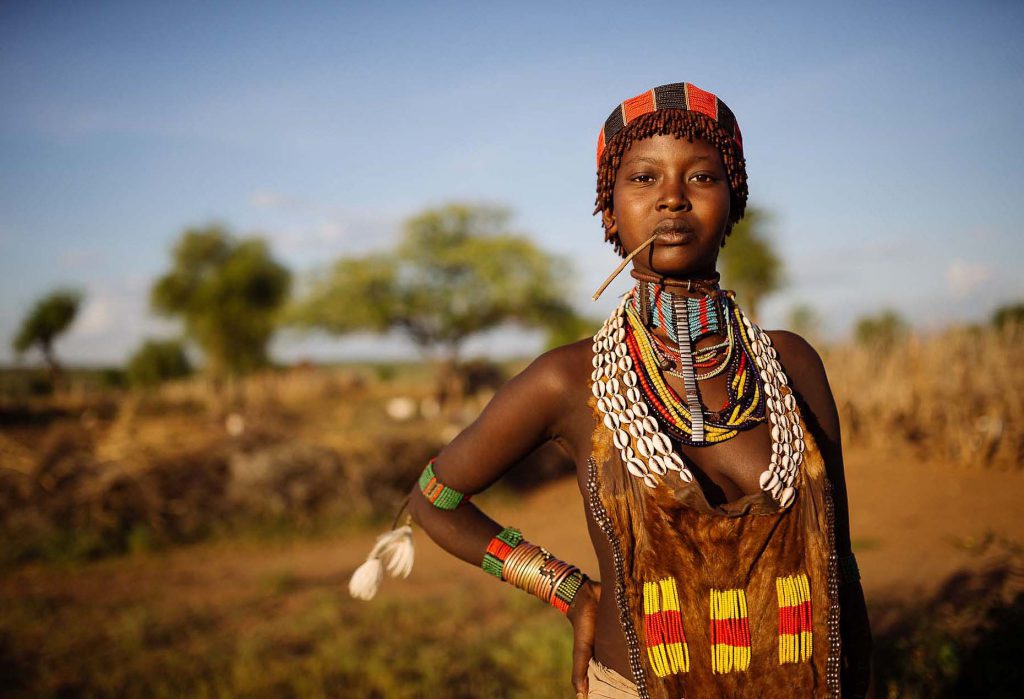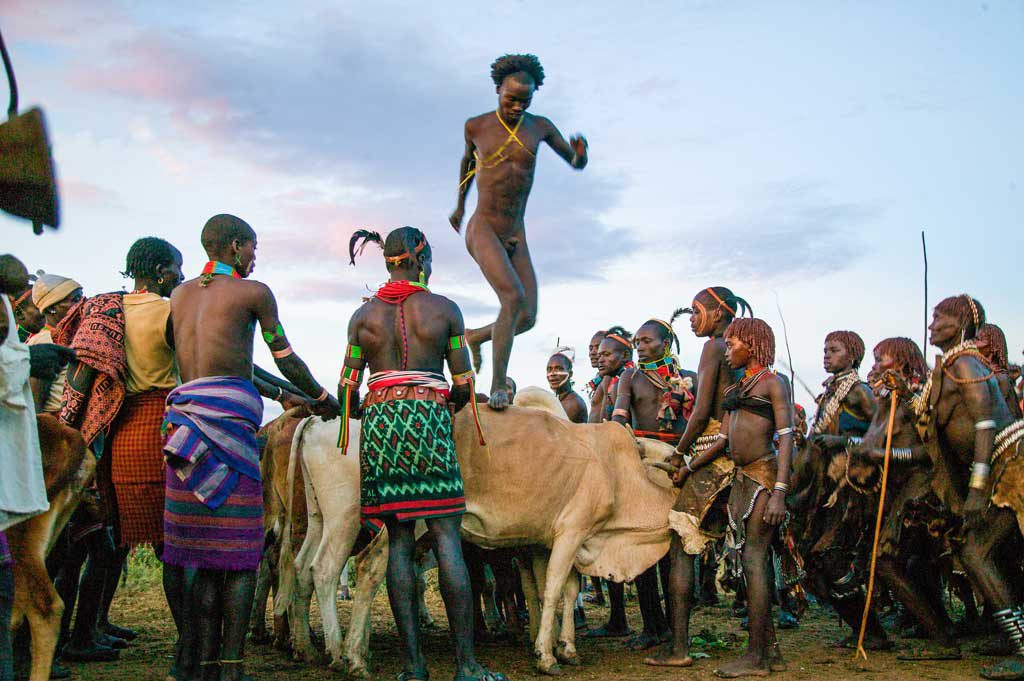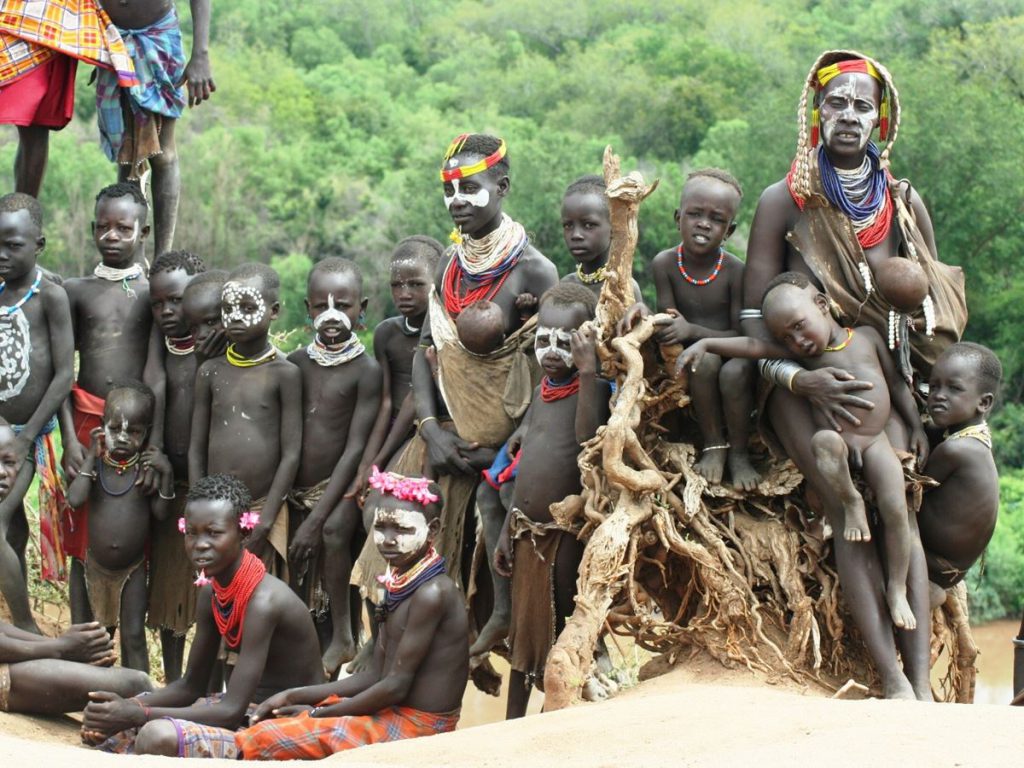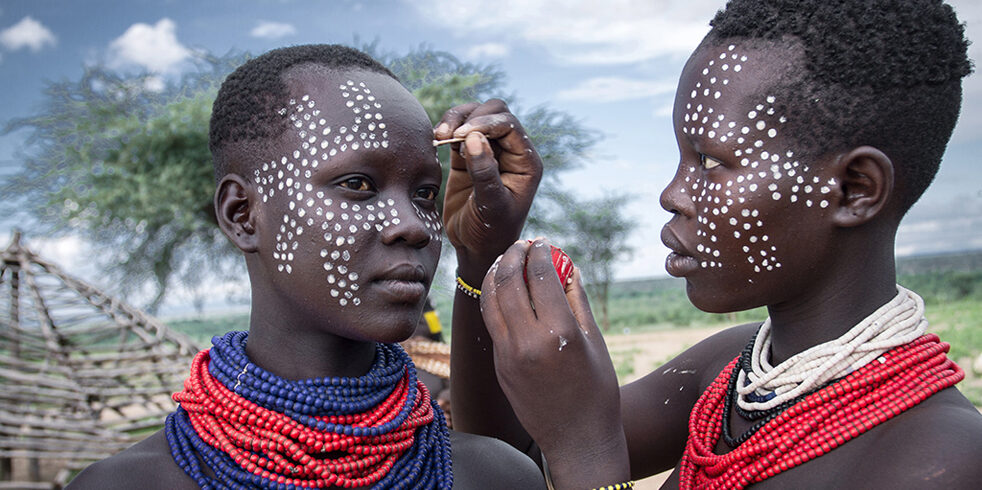The Omo Valley is cohabited by a colourful mix of tribes practising a mixture of pastoralism, small scale cattle herding and subsistence agriculture. The Karo are expert body painters, using clays and locally available vegetable pigments. Hamar women wear their hair in dense ringlets smeared with mud and clarified butter and topped off with head-dresses of aluminium. The men mould extravagant ochre mud caps.
The Omo Delta is a little known corner of the Valley. Accessed by boat, and an important archaeological site in terms of tracing our evolutionary beginnings, the Omo Delta is a stunningly remote area of islands and marshes. Inhabited by the Dassanech and crocodile hunting El Molo tribes, it is also of immense anthropological importance. Virtually untouched, the Dassanech villages are scattered among the islands, and in the riverine forest that runs north along the banks of the Omo River, and on into southern Ethiopia.
Overview
The order of sites visited in the Omo valley can change depending upon lodge availability and weekly market days.
<p>Drive to Arba Minch, one of the main towns in Southern Ethiopia. On the way, visit a Dorze Village in the Guge Mountains. The Dorze are known for their tall, beehive-shaped bamboo houses. If the base becomes infested with termites, the entire house can be lifted and moved to another location.</p><p>Overnight Lodge</p>
<p>Take a boat trip on Lake Chamo and view some of the largest crocodiles in the world sunning on the banks of the lake. Hippopotami and birdlife are also abundant. Drive to Jinka visiting various peoples such as the Gamo and Derashe. Stop at Key Afar’s weekly market (if on a Thursday) and wander among the various tribes such as the Benna and Ari that have gathered to barter their goods. </p><p>Overnight Lodge </p>
<p>Early morning drive to the Mago National Park to visit the Mursi people. The Mursi women are known for the clay plates they insert into their lower lips. Time permitting, visit the Omo Valley Museum in Jinka.</p><p>Overnight Lodge (B, L, D)</p>
<p>Drive to Turmi to visit the Hame eople who are well known for the scarring of their bodies, using clay to shape their hairstyles, and the unique practice of “bull-jumping” which every young man must accomplish prior to marriage. En route to Turmi, visit the Benna and Ari people. </p><p>Overnight Lodge (B, L, D)</p>
<p>Excursion to Omorate visiting the Dassanech people. Return to Turmi for the evening.</p><p> Overnight Lodge </p>
<p>Drive to Konso, recently designated as a UNESCO World Heritage site. A highland people, the Konso are known for the ancient and intricate terraces that encircle their well-planned villages.</p><p> Overnight Lodge </p>
<p>Drive to the lakeside town of Hawassa.</p><p></p><p>Rest and relaxation at one of Hawassa’s fine resorts.</p><p>Overnight Hotel</p>
<p>Visit the Hawassa fish market in the morning. Drive to Addis Ababa making stops at the Rift Valley Lakes. In the evening, enjoy a farewell dinner at a traditional Ethiopian restaurant featuring dancers and musicians representing some of the country’s many ethnic groups. Transfer to airport for late night departure</p><p> End of Tour</p><p>Scenic tours will arrange additional hotel nights in Addis Ababa upon request.</p>
Price Includes:
- hotel
- meal
- transportation
- extra..............
Price doesn't Include:
- flight
- extra expense
- extra.........
Good things come in small packages, which is why we keep our group sizes down. This means we’re small enough to remain flexible as we thread our way through communities without intimidating the locals. On most of our trips you’ll be part of an intimate group of 12-16 people, though our group sizes are on average 10 people. Our Overland trips are in purpose-built vehicles that can carry up to 24 travellers. Group sizes are displayed on each trip’s overview page on our website.
While we can’t tell you who your leader is prior to departure, we can tell you they will be awesome. Our leaders are experts in their regions, some because they’ve been travelling there for years, others because they’re local to the region and can’t wait to show you around. On longer journeys, or ones that travel through more than one country, you may change leaders part way through – but this just means double the awesomeness.
Although you won’t be reimbursed for any portion of the trip unused, you can opt to sign off the trip if you need to leave a day or so earlier. If you let us know before travel that you’ll be arriving late or need to leave before the trips ends, we will notify our team on the ground to best accommodate your requirements.
Food is one of the most exciting parts of travel. There may be some familiar fare but often you’ll be confronted with the new, interesting and downright weird of the culinary world but we like to think of it as an adventure for all the senses. In addition to this, our flexible itineraries often allow you to eat with the group or branch out on your own – this means you can eat to suit any budget or desire.
Intrepid has treks ranging from relatively easy to extremely difficult. The easiest way to determine if a trek is right for you is to check the ‘physical rating’ of the trip (this can be found on our website at the top of the trip’s overview page).
If it moves there’s a good chance you’ll be riding on it. The type of transport used depends on your trip style. Find out more or see your Essential Trip Information for the specific type of transportation used on your journey.
Communication facilities are always improving globally. Many hotels and public places have Wi-Fi so it’s usually possible to keep in touch with home every couple of days, if you so desire. In remote places (think Mali, Serengeti or the Sahara) or on treks or homestays, you will not be able to communicate as readily. Your leader will usually give you the heads up before you leave a place so you can send a quick email or two. Phone cards are easy to get your hands on; just make sure your phone is unlocked before you travel. Or in many countries, the cheapest way to make a phone call is at an internet cafe.
We can never guarantee your phone will work as desired, as many of our destinations are out of the way and you may have limited coverage. Chat to your phone provider before you leave about global roaming and the costs involved, and get their advice on the coverage you’ll receive in the places you’re travelling in. Alternatively, you can usually pick up a local sim card on the cheap (just make sure you phone is unlocked!).
Some places have Wi-Fi hot spots everywhere and other places will have no coverage at all. If you stumble into the latter, take the rare chance to just sit back and get to know your fellow travellers the old-fashioned way.



